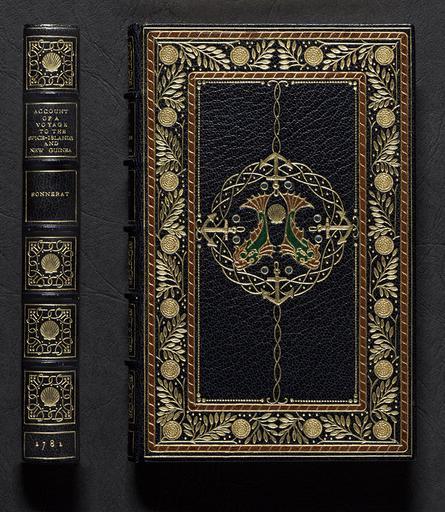MAKE A MEME
View Large Image

| View Original: | Binding_by_Sangorski_&_Sutcliffe,_1913.jpg (890x1024) | |||
| Download: | Original | Medium | Small | Thumb |
| Courtesy of: | www.flickr.com | More Like This | ||
| Keywords: bookbinding historic antique book binding indoor photo border picture frame Sangorski & Sutcliffe's love of jewelled bindings is well demonstrated here. The navy goatskin has been gold-tooled and inlaid with green, brown, and light blue goatskin in an almost cloisonné-like style. The central nautical theme with fish and anchor, and the clamshell motif on the spine are apt reflections of the tale within, Voyage to the Spice Islands. The endleaves and pastedowns are of brown watered silk. Sangorski and Sutcliffe was a leading firm of craftsman binders founded in 1901 by Francis Sangorski (1875-1912) and George Sutcliffe (1878-1943). Both had studied under Douglas Cockerell at London's Central School of Arts and Crafts. Sangorski and Sutcliffe's lavish use of coloured leathers, gold, and semi-precious stones, combined with innovative motifs, resulted in richly detailed bindings. A well-known example of one of their more extravagant bindings was the 'Great Omar', one of many designs this firm produced for the Rubáiyát of Omar Khayyám. The 'Great Omar', commissioned by Sotherans, a bookselling and auctioneering firm, contained 1050 jewels set amongst colourful inlays and heavy gold tooling. Sadly this volume was lost in the sinking of the Titanic and a later copy was destroyed in the Second World War, leaving only photographs of the work. Purchased by Alexander Turnbull. Upper cover and spine of Pierre Sonnerat, ‘Voyage to the Spice Islands’ (Bury St. Edmund’s: Reprinted and sold by W. Green, [1781]). REng SONN Acco 1781. Sangorski & Sutcliffe's love of jewelled bindings is well demonstrated here. The navy goatskin has been gold-tooled and inlaid with green, brown, and light blue goatskin in an almost cloisonné-like style. The central nautical theme with fish and anchor, and the clamshell motif on the spine are apt reflections of the tale within, Voyage to the Spice Islands. The endleaves and pastedowns are of brown watered silk. Sangorski and Sutcliffe was a leading firm of craftsman binders founded in 1901 by Francis Sangorski (1875-1912) and George Sutcliffe (1878-1943). Both had studied under Douglas Cockerell at London's Central School of Arts and Crafts. Sangorski and Sutcliffe's lavish use of coloured leathers, gold, and semi-precious stones, combined with innovative motifs, resulted in richly detailed bindings. A well-known example of one of their more extravagant bindings was the 'Great Omar', one of many designs this firm produced for the Rubáiyát of Omar Khayyám. The 'Great Omar', commissioned by Sotherans, a bookselling and auctioneering firm, contained 1050 jewels set amongst colourful inlays and heavy gold tooling. Sadly this volume was lost in the sinking of the Titanic and a later copy was destroyed in the Second World War, leaving only photographs of the work. Purchased by Alexander Turnbull. Upper cover and spine of Pierre Sonnerat, ‘Voyage to the Spice Islands’ (Bury St. Edmund’s: Reprinted and sold by W. Green, [1781]). REng SONN Acco 1781. | ||||